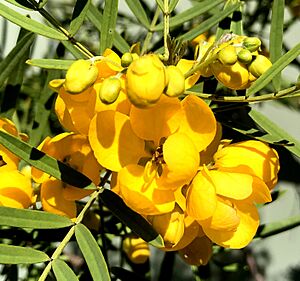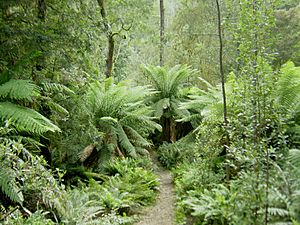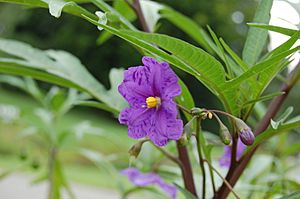Flora of Australia facts for kids
The flora of Australia is an amazing collection of plants! There are over 21,000 types of vascular plants (plants with tubes to carry water) and 14,000 types of non-vascular plants (like mosses). Plus, there are around 250,000 kinds of fungi and over 3,000 types of lichens. Many of Australia's plants are found nowhere else in the world.
These plants have special ways of dealing with Australia's dry weather and bushfires. For example, many have tough, leathery leaves (called scleromorphy) or seeds that only open after a fire (called serotiny). You can see these adaptations in famous Australian plants like the Banksia (from the Proteaceae family), Eucalyptus (gum trees from the Myrtaceae family), and Acacia (wattle trees from the Fabaceae family).
Humans have also changed Australia's plant life. When Aboriginal people lived here, they used "fire-stick farming" to manage the land, which changed where some plants grew. Since Europeans arrived in 1788, a lot of land has been cleared for farms and cities. This has caused 61 plant species to disappear by 2006, and over 1,000 more are now in danger.
Contents
How Australia's Plants Came to Be
Long, long ago, Australia was part of a giant supercontinent called Gondwana. This huge landmass also included places like South America, Africa, India, and Antarctica. Back then, during the Cretaceous period, Australia was covered in warm, wet rainforests. Many of Australia's ferns and ancient flowering plants are similar to those found in Gondwana.
About 140 million years ago, Gondwana started to break apart. Australia slowly drifted away from Antarctica about 50 million years ago. This journey caused big changes in the climate. Australia became drier and warmer, and bushfires became more common. These new conditions led to the evolution of many unique Australian plants.

Between 25 and 10 million years ago, many new types of plants appeared quickly, like Eucalyptus, Casuarina, Allocasuarina, Banksia, and pea-flowered plants. Grasslands also started to grow. When Australia eventually bumped into Asia, some new plant types from Southeast Asia also joined the Australian flora.
The dry conditions and old, poor soils in Australia made plants develop special ways to survive. Many plants have hard leaves with a thick outer layer to stop water loss. Some plants also have special ways of taking in carbon dioxide that help them save water.
Bushfires became more frequent as Australia got drier. Fire has played a big role in shaping Australia's plant life. When Aboriginal people arrived around 38,000 years ago, their use of controlled fires (fire-stick farming) also helped shape the forests, especially on the east coast. Many Australian plants have amazing adaptations to fire. For example, Eucalyptus and Banksia trees can regrow quickly from special buds or underground stems after a fire. Some plants, like Xanthorrhoea (grass trees) and certain orchids, even flower only after a fire!
Australia's Unique Plant Regions
Australia is often seen as its own special "plant kingdom" because it has so many unique plant families. Many plant families, like Eupomatiaceae, Pittosporaceae, and Goodeniaceae, first appeared here. Other families, like Poaceae (grasses), Fabaceae (legumes), and Myrtaceae (eucalypts), are very common in Australia.
Types of Plant Life in Australia
Australia's plant life can be divided into different groups based on where they grow. The most important factor is rainfall, followed by temperature. The National Vegetation Information System (NVIS) divides Australia's land plants into 33 main groups.
The most common plant types are those that can handle dry conditions. The biggest type is the hummock grasslands, found in dry parts of Western Australia, South Australia, and the Northern Territory. These grasslands cover 23% of Australia's native plants, and the main plants are from the Triodia genus.
Another 39% of Australia's native plants are covered by these types:
- Eucalypt woodlands: These are found where there's not enough rain for thick forests, but enough for trees to grow. They often have grass or shrubs underneath.
- Acacia forests and woodlands: These grow in semi-dry areas where trees don't get very tall. Different Acacia species, like mulga and brigalow, grow depending on the location.
- Acacia shrublands: These are common in dry and semi-dry regions, mostly mulga shrublands.
- Tussock grasslands: These grow in semi-dry and some cooler parts of Australia and have many types of grasses.
- Chenopod/samphire shrubs and forblands: These are found near salty areas and in dry regions. The plants here can handle drought and salt.
Smaller areas have other plant groups like tropical or temperate rainforests, tall eucalypt forests, and heathlands.
Vascular Plants of Australia
Australia has over 21,000 known types of vascular plants. These include angiosperms (flowering plants), seed-bearing plants that aren't flowering plants (like conifers and cycads), and spore-bearing plants (like ferns). About 85% of Australia's vascular plants are endemic, meaning they are found only in Australia.
Flowering Plants (Angiosperms)
Flowering plants are the most diverse group. Australia's most famous flowering plants come from three large families: the Fabaceae, the Myrtaceae, and the Proteaceae.

- Myrtaceae: This family includes many woody plants like Eucalyptus (gum trees), Syzygium (Lillipillies), Melaleuca, Bottlebrush, and Leptospermum (teatrees).
- Proteaceae: Australia has many types of Proteaceae, including well-known plants like Banksia, Dryandra, Grevillea, Hakea, and the waratah. The macadamia nut, Australia's only native commercial food crop, also comes from this family.
- Fabaceae: This family includes all three types of legumes. The pea-flowered legumes (Faboideae) are common and known for their beautiful flowers, like the Sturt's desert pea. The Mimosoideae group is famous for the huge Acacia genus, which includes Australia's national flower, the golden wattle.
Other well-known flowering plants include:
- Grasses (Poaceae): This family has many species, from tropical bamboo to the tough spinifex that grows in dry Australia.
- Orchids (Orchidaceae): Australia has over 800 types of orchids. Many terrestrial (ground-growing) orchids die back in dry seasons and regrow from a tuber when it rains.
- Daisy family (Asteraceae): This family is well-represented by its "paper daisies" or "everlasting daisies," which are very diverse in Australia.
- Rutaceae: This family includes fragrant shrubs like Boronia.
- Ericaceae: This family includes Victoria's floral emblem, Epacris impressa.
Australia also has unique plants like the Xanthorrhoea (grass trees), Pandanus (screw palms), and many native palms. Some ancient hardwood trees include Casuarina (oaks) and Nothofagus (southern beeches).
In Australia's salt marshes and wetlands, you'll find many plants that can handle salt and drought, like the saltbushes (Atriplex). Australia also has a huge variety of seagrass meadows and 39 types of mangroves.
Conifers and Cycads (Gymnosperms)
Gymnosperms in Australia include cycads and conifers. There are 69 species of cycads. Native conifers belong to 3 families and 14 genera, with 39 species found only in Australia. Most conifers grow in wet, mountainous areas, showing their ancient Gondwanan roots. A special conifer is the living fossil Wollemi pine, discovered in 1994. Even though many Australian conifers are called 'pines', there are no true pine trees (from the Pinaceae family) native to Australia.
Ferns and Fern Allies
Ferns and fern allies are plants that reproduce using spores. Australia has 390 native species of ferns, mostly found in tropical and subtropical areas with lots of rain. Ferns need water to reproduce, so they often grow in bushland and rainforests. Some ferns grow in water, some on other plants (epiphytic), and some on the ground, including large tree ferns.
Non-Vascular Plants
- Algae: This is a huge group of plants that make their own food using sunlight. Australia has about 10,000 to 12,000 known species of algae, found in fresh and saltwater.
- Bryophytes: These are simple plants like mosses, liverworts, and hornworts. They usually grow in damp places, but some can live in dry areas. Australia has nearly 1,000 types of moss and over 800 types of liverworts and hornworts.
Fungi and Lichens
- Fungi: Australia is thought to have about 250,000 species of fungi, but only about 5% have been described so far.
- Lichens: Lichens are like two organisms living together: a fungus and a tiny green alga. Australia has over 3,200 species of lichens, and 34% of them are found only here.
How Humans Use Australian Plants
The first Australian plants were officially named and classified in 1768. Later, in 1770, Captain Cook's expedition landed at what is now Botany Bay, and scientists like Joseph Banks began studying the plants there.
Indigenous Australians used thousands of plant species for food, medicine, shelter, tools, and weapons. For example, they used the roots of Clematis microphylla to make dough and its leaves to treat skin problems.
Since European Settlement
Europeans used many native plants for timber and paper, like different types of eucalypts, Huon pine, and cypress pine. The pastoral industry (raising livestock) also uses native grasses like Mitchell grass and kangaroo grass for animal feed.
Commercial Uses Today
For a long time, the macadamia nut was one of the only Australian food plants widely grown for sale. But since the late 1970s, more native foods have become popular. These include:
- Wattles for their edible seeds.
- Fruits like Davidson's Plum, desert lime, quandong, and Kakadu plum.
- Leafy vegetables like warrigal greens.
- Spices like lemon myrtle and mountain pepper.
Some Australian plants are also used in medicine, like Duboisia species for certain chemicals, and essential oils from Melaleuca (tea tree oil) and Eucalyptus. Because of their beautiful flowers and leaves, Australian plants are also popular around the world for gardens and flower arrangements.
Protecting Australia's Plants
Human activities have greatly changed Australia's plant life.
Threats to Plants
Since 1788, changes have been very fast. The way Aboriginal people managed fire was disrupted. Forests have been changed by logging, wetlands have been filled, and huge areas have been cleared for farming and cities. This has led to problems like salty land, polluted rivers, and loss of plant and animal homes. Also, plants and animals brought from other countries (invasive species) are a big threat to native plants.
Plants in Danger
By 2006, 61 plant species had disappeared since Europeans arrived, and another 1,239 species were considered threatened or endangered.
Protected Areas
To protect Australia's unique plants and ecosystems, many protected areas have been created. These include national parks and other reserves. As of 2002, over 10% of Australia's land area is protected. Marine protected areas also exist to save ocean plants and animals.
Biodiversity Hotspots
In 2003, the Australian government identified 15 "biodiversity hotspots" – areas with many different types of plants and animals that are also under threat. Efforts are being made to protect these important areas.
Images for kids
-
A riparian zone with casuarina and eucalyptus species in Sydney.
See also
 In Spanish: Flora australiana para niños
In Spanish: Flora australiana para niños








